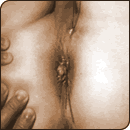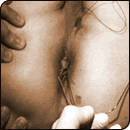Fistulotomy – Fistulectomy
Routine Use of Setons for the Anal Fistula Treatment
Abstract
Aim : Anal Fistula Treatment is usually treated by either fistulotomy or fistulectomy. We described the routine use of setons to treat anal fistula without any surgery.
Method : Forty-seven consecutive patients with diagnosed anal fistula treatment were treated using setons alone.
Results : The median age of the patients was 41 (range: 18-70). Of the 47 patients, 15 had surgery previously for fistula and perianal abscess. At least two setons were inserted through each fistula. One was tied tightly to function as a cutting seton and this was sequentially tightened by the patient and another was tied loosely for drainage. Of the 47 patients, 33 (70%) had the placement of setons in the clinic without any anaesthesia. The remaining 14 patients had the setons inserted in the operating room, with one patient having a complex anal fistula and 13 patients having perianal abscess requiring drainage at the same time. There were no post procedure complications in the series. Forty-one patients had completed follow up at clinic within a median duration of 15 weeks (range: two to 67 weeks). The fistula was completely healed by this method in 37 patients (78%). The median healing time was nine weeks (range: four to 62 weeks). One patient developed recurrent fistula and was healed after another seton placement. No patient developed any faecal incontinence and all patients were satisfied with this treatment.
Conclusion: The routine seton method is safe, cheap and effective in the treatment of anal fistula regardless of type. It does not leave an open wound and most patients are satisfied with the treatment.
Keywords: fistula, transphincteric, intersphincteric, seton, treatment.
Introduction
Fistula-in-ano is a common perianal condition that is associated with appreciable morbidity and inconvenience to the patient. The morbidity increases with the more complex or high type of fistulae. The most notable classification of fistula type is by Park’s and this is based on the relationship between the fistula track and the anal sphincters. However, the complexity and the relevance of this classification raise doubts of its use in the routine management of anal fistula.
The principles of anal fistula surgery are to eliminate the fistula, prevent recurrence and preserve sphincter function. Success is usually determined by identification of the primary opening and dividing the least amount of sphincteric muscle possible. Most of the anal fistulae have been conventionally treated by either fistulotomy or fistulectomy, which have proven to be effective (2). However, the procedure requires local, regional or general anaesthesia. Post-operative wounds are usually left open and take much time to be completely healed through secondary intention. Furthermore, there exists a noticeable risk of recurrence and incontinence especially in high risk patients with complex or high fistulas, women with anterior fistulas and elderly patients.
Setons have been used to manage anal fistula for hundreds of years. In the literature, setons were commonly described only for the high or complex anal fistula in order to avoid faecal incontinence and recurrence’3′. The usage of this method was deemed cumbersome and too slow.
In this study, we have described the initial results of the routine use of the two setons placement method, comprising one drainage seton and another primary cutting seton, for all consecutive patients with any type of anal fistulae in the outpatient clinic.
Methods
A prospective series of 47 consecutive patients with anal fistula managed by seton placement between July 1997 to December 2000 was studied.
Fig.1 The cutting seton and another seton for drainage were placed along the fistula tract.
Technique
The seton was usually inserted at the clinic without any form of anaesthesia. In a few cases when there was concurrent perianal abscess, difficulty in identifying the fistula tract or when the patients were unable to tolerate the examination, the procedures were performed in the operating room with a brief general anaesthesia. The patient was examined in the left lateral position. Per-rectal examination would reveal the diagnosis and the fistula tract was identified using a probe. In the initial eight patients, fistulogram was done to give the surgeon a feel of the complexity of the tract. However, the fistulogram was discontinued in other cases as tracking of fistula was not improved by fistulogram in our hands. A non-absorbable suture monofilament Prolene O (Ethicon, Edinburgh, UK) was inserted through the external opening using a fine buttonhole probe. Two sutures were then threaded through the internal opening. A Roders knot was made for each seton and left loosely. The suture with the long tail will become the cutting seton. The second seton with the short tail served as a drain for the infection (Fig. 1). Multiple setons would be inserted when there were more than one tract. The patient was instructed to pull the long tail of the cutting seton till he felt the pain was not tolerable on a daily basis one week after the procedure.
Repeated examinations were carried out at four-week intervals. At each visit, the position of the seton was assessed. The data of previous anal operations, history of patient incontinence before and after seton treatment, wound healing, and recurrence of anal fistula was recorded. Telephone surveys were conducted by a research nurse to detect any recurrence and any problems of faecal incontinence regularly every six to 12 months. A satisfactory score to the treatment was finally obtained from each patient at the end of the telephone survey.
Results
The series comprised 47 patients with 41 males (87%) and six females (13%). The median age was 41 (range: 18-70). Fifteen patients (32%) had previous anal operation, of which seven patients had anal fistula, six patients had perianal abscess and two patients had haemorrhoidectomy. The median duration of symptoms was 26 weeks (range: two to 416 weeks). Thirty-three patients (70%) had the placement of setons in the clinic without any anaesthesia. Fourteen patients had the setons inserted in the operation room. Six patients required general anaesthesia, of which four patients had drainage of perianal abscesses. Prior to the placement of setons, two patients had the setons inserted under intravenous sedation. Forty-one patients were continuously followed-up until the wounds were completely healed and only one patient self referred to other hospitals. The last five patients are now followed in the clinic and all of them are progressing very well. Of these 41 patients with completed follow-up, none revealed major faecal incontinence after the end of treatment.
The median follow-up duration was 15 weeks (range: two to 67 weeks). The fistula was completely healed by this method in 37 out of 41 patients (90%). The median healing time was nine weeks (range: four to 62 weeks). The patient who took 62 weeks to heal after the first seton was inserted had a complex fistula and had undergone five operations previously. One patient had fistulectomy subsequently as he required haemorrhoidectomy for his prolapsed piles. Another patient developed a recurrent fistula which was low and was healed after another seton placement. Six patients defaulted follow-up but their fistulas were observed to be cut through by the setons at their last clinic visits. All patients were satisfied with the treatment and no patient developed any faecal incontinence.
Discussion
The age distribution and male predominance (87%) seen in this series are similar to most other series(2,4). Our study suggests that the majority of anal fistula can be treated successfully with setons alone without any surgery. Most of our patients tolerated the procedure well and were satisfied with the treatment.
Anal fistula is believed to originate from an infection of the anal glands. The main principles of management are drainage of infection and eradication of fistulous tract with preservation of sphincter function (5). The majority of peri-anal fistulae are low fistulae which include the submucous, intersphincteric, and most of the transsphincteric types of anal fistula. Conventionally, this type of fistula is treated by either laying open (fistulotomy) or excising the fistulous tract (fistulectomy). For some trans-sphincteric fistula, an alternative technique called transanal advancement flap has been advocated for many years (6). Even though this technique also yields excellent functional results, it demands higher and more complicated skills (7). These procedures are associated with considerable pain and require some form of anaesthesia. The patient needs to be hospitalised for the operation. Moreover, the open wound of conventional surgery needs repeated dressing, which brings further discomfort and inconvenience to the patients.
A seton is a thread of foreign material that is placed in the fistula tract. Hippocrates first described this method (8). Many different materials have been used as setons, but the more common ones are suture, rubber, wire, and medicated thread (kshaarasootra) (9). Conventionally, the seton is used for the management of high or complicated anal fistula (3). The function of the seton is to provide drainage, to induce chronic fibrosis, and to cut the fistulous tract with preservation of the sphincter mechanism. Two common techniques have been used: the cutting seton, and the two-staged fistulotomy(10). For the cutting seton method, the seton is tied tightly around the fistulous tract. It will gradually transect the muscle by pressure necrosis and the fibrosis fixes and prevents retraction of the sphincter. In the two-staged fistulotomy, the seton is tied loosely and the fistulotomy is performed as second procedure. The seton serves as drainage and it also induces fibrosis.
Only one report in the literature described the use of seton for low anal fistula. Lentner et al reported the result of long-term indwelling seton low transsphincteric and intersphincteric anal fistula (11) .In his series of 108 patients, a seton using non-absorbable suture was tied loosely through the fistula tract. The author reported a very low recurrence rate (3.7%) with minimal risk of incontinence. Only 12 patients in the series required in-patient treatment and the overall mean hospital stay was 0.3 day. However, the treatment was prolonged with a median of 13 months and a significant proportion of patients (44%) required another operation for the residual fistulous tract.
In our series, we used two setons for each fistula tract. They served the two different functions of seton therapy. The loose seton allowed drainage of the ongoing infection. Another seton was a cutting seton which was tied tightly outside the fistula. The Roder’s knot enabled the patient to adjust the tension daily so that the seton could cut the tract in a controlled fashion (12). The cutting seton probably reduced the period of treatment. Most of our patients had the insertion of seton in the clinic though some required general anaesthesia in the operating room, especially those with concurrent perianal abscess.
The median follow-up duration was 15 weeks (range: two to 67 weeks). The fistula was completely healed by this method in 37 out of 41 patients (90%). The median healing time was nine weeks (range: four to 62 weeks). The patient who took 62 weeks to heal after the first seton was inserted had a complex fistula and had undergone five operations previously. One patient had fistulectomy subsequently as he required haemorrhoidectomy for his prolapsed piles. Another patient developed a recurrent fistula which was low and was healed after another seton placement. Six patients defaulted follow-up but their fistulas were observed to be cut through by the setons at their last clinic visits. All patients were satisfied with the treatment and no patient developed any faecal incontinence.
In conclusion, our method provides an alternative to the conventional operative treatment for all anal fistulae. The results from the routine use of setons is safe and effective regardless of the type of anal fistula. This traditional treatment for fistula-in-ano also has the advantage of being considerably cheaper than inpatient operative methods and may allow the patient to continue employment. In future, comparative studies with conventional surgery are required to confirm its role in the management of all anal fistulae.




















